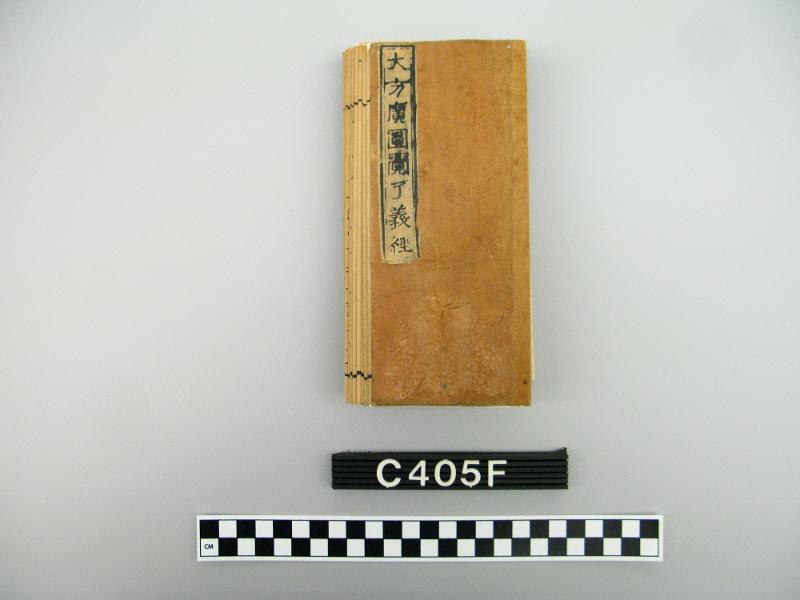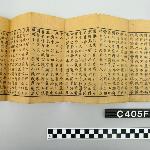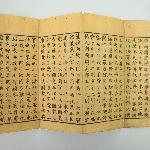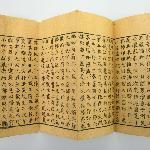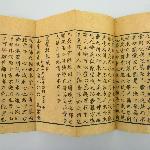| Object Number | C405F |
| Current Location | Collections Storage |
| Culture | Chinese | Buddhist |
| Provenience | China |
| Period | Yuan Dynasty |
| Date Made | Yuan Dynasty |
| Section | Asian |
| Materials | Paper |
| Technique | Woodblock Printed |
| Iconography | Buddhist Text |
| Inscription Language | Chinese Language |
| Description | A woodblock printing of the well-known Chinese Buddhist text, the Sutra of Perfect Enlightenment (Yuan jue jing 圓覺經, or in full, Dafangguang yuanjue xiuduoluo liaoyi jing 大方廣圓覺修多羅了義經, T17n0842). Along with several other books and manuscripts, this item was in the cavity of lacquer statue C405A at the time that item was aquired by the museum in 1923. The sutra text consists of a series of responses by the Buddha to doctrinal questions raised in turn by twelve Bodhisattvas, beginning with Mañjuśrī. Each response consists of a prose exposition, the essence of which is then summarized in a gāthā or metrical verse section. The sutra is attributed to a translator called Buddhatāra 佛陀多羅, but may have been an 8th c. Chinese composition in origin, rather than a translation of an Indian original as it purports to be. Besides the sutra itself, this edition of the text includes prefaces (T39n1795) by the Tang dynasty commentators Zong Mi 宗密 and Pei Xiu 裴休, and on the final page a set of reading pronunciations and glosses. It is printed using twenty woodblocks, each with 56 columns of 14 characters. The accordion-folded paper has been more recently remounted onto white paper. The printing is not dated, but there are two printing notices, one following the two prefaces, and one at the very end.
真州比丘普桂命工刊此經板流通誦念者。 Monk Pu Gui of Zhenzhou ordered the craftsmen to cut this sutra woodblock so that it might circulate among those who recite the scriptures. Zhenzhou is the name of a prefecture in Jiangsu that existed until the mid 14th c. 天台華頂比丘普興施錢四定刊圓覺一經,伏願義天朗耀,心地開通,成就惠身,靜極覺徧。 Monk Pu Xing of the Huading Monastery of Tiantai Mountain, donated money [four somethings?] for a woodblock printing of the Sutra of Perfect Enlightenment, humbly wishing for the brilliant light of the Heaven of Highest Meaning, for the opening of minds, for the attainment of the wisdom body, that quiescence be supreme and that enlightenment be pervading. The printed text here, as with the Taishō version, is missing the gāthā from the last of the twelve dialogues, namely that with the bodhisattva Most Excellent of Worthies 賢善首. The Japanese supplementary canon contains a 1912 notice (X01n0001) of a Song edition preserving the missing gāthā. A separate manuscript addition to the text is on a further sheet, similarly remounted and folded within the printed text. The manuscript consists of two metrical texts, one in five syllables and one in seven. The five-syllable is the gāthā missing from the printed text, and matches that recorded in 1912. The manuscript is clearly in a student hand as there are a number of startling errors, including 來如 corrected to 如來, 丘 for 兵, and 風諷 for 風調. |
| Credit Line | Purchased from C. T. Loo, 1923 |
Report problems and issues to digitalmedia@pennmuseum.org.


